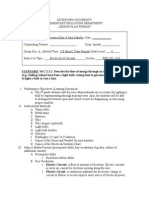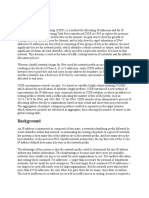CAPS Technology Lesson Plan
CAPS Technology Lesson Plan
Uploaded by
luzflyCopyright:
Available Formats
CAPS Technology Lesson Plan
CAPS Technology Lesson Plan
Uploaded by
luzflyCopyright
Available Formats
Share this document
Did you find this document useful?
Is this content inappropriate?
Copyright:
Available Formats
CAPS Technology Lesson Plan
CAPS Technology Lesson Plan
Uploaded by
luzflyCopyright:
Available Formats
PHAKANI COMBINED SCHOOL GRADE 8
SUBJECT: TECHNOLOGY
EDUCATOR: MR TW TSHABALALA
STUDY AREA:
ELECTRICAL SYSTEMS AND
CONTROL
TOPIC: GENERATING
ELECTRICITY
TERM: 4
DATE: 04 - 05 November 2014
WEEK: 3
TIME/DURATION: 100 minutes
Prior knowledge/Introduction:
Learners are aware of the components of electric circuits.
They know about electrochemical cells and photovoltaic cells.
They realize their own dependence on electricity and its importance on our lives.
Many sectors of the economy in our country need electricity for production, which increases the demand for
electricity even though the supply its supply is limited by environmental issues.
Common misconceptions:
Many learners are not aware of the range of alternative energy sources being developed.
Those who have the idea how electricity is generated in SA only have a limited understanding and
believe that electricity is generated from coal.
Content:
Thermal power stations: Coal power station, Solar power stations and Nuclear power stations.
Hydroelectric power stations.
Wind-driven turbines.
Alternating current
Teacher activities:
Encourage learners to be more aware of their environment and identify environmental examples of
energy sources.
Make a presentation on how the thermal power stations, hydroelectric power stations and winddriven turbines.
Discuss the advantages and disadvantages of each method of electricity generation.
Discuss alternating current, step-up and step-down transformers and how electricity is distributed
across the country through the national grid.
Learner activities:
Take part in class discussions, asking for clarification and sharing their understanding.
Completing classwork
Completing homework.
Class work:
Student worksheet printout
Learner book:
Page 171 Activity 1: Fossil fuels.
Page 172 Activity 2: Nuclear power.
Home work:
Page 172 Activity 3: Nuclear power.
Page 173 Activity 4: Comparing energy sources.
You might also like
- Digital Marketing in The Automotive Electronics Industry: Uli Schneider Jürgen Hoika EditorsDocument249 pagesDigital Marketing in The Automotive Electronics Industry: Uli Schneider Jürgen Hoika EditorsWalterNo ratings yet
- Volvo Guided Diagnostics: Data Bus System Supervision Data Bus Communication, Description Control Unit, DescriptionDocument2 pagesVolvo Guided Diagnostics: Data Bus System Supervision Data Bus Communication, Description Control Unit, DescriptionGetsuga Tensho Gaming50% (2)
- Understanding Healthcare Access in IndiaDocument46 pagesUnderstanding Healthcare Access in IndiaNaveen KrishnaNo ratings yet
- INTERPOL Response Lyle StevikDocument2 pagesINTERPOL Response Lyle StevikThomas GNo ratings yet
- Soal Soal ToeicDocument8 pagesSoal Soal ToeicJihan Rosa Khairunnisa0% (1)
- UBD Lesson Plan - Science 3rd QRTRDocument3 pagesUBD Lesson Plan - Science 3rd QRTRJean Acutillar PaguiaNo ratings yet
- Unit of WorkDocument8 pagesUnit of Workapi-378962710No ratings yet
- Renewable Energy EngineeringDocument2 pagesRenewable Energy EngineeringBVishal Mistry0% (1)
- 00 EET3196 Lecture - Tutorial Ouline Plan1Document6 pages00 EET3196 Lecture - Tutorial Ouline Plan1mikeNo ratings yet
- Enst Renewable Energy Syllabus 2015 1Document6 pagesEnst Renewable Energy Syllabus 2015 1api-303214818No ratings yet
- CM610 - Principles and Applications of ElectrochemistryDocument1 pageCM610 - Principles and Applications of ElectrochemistryDhanvin PrajapatiNo ratings yet
- All About Wind Lesson PlanDocument2 pagesAll About Wind Lesson Planapi-241659436No ratings yet
- Earthscienceforstem q1 Mod8 Energyresources SCDocument36 pagesEarthscienceforstem q1 Mod8 Energyresources SCSOLACE CORTEZNo ratings yet
- Electricityunit 1Document19 pagesElectricityunit 1api-288336054No ratings yet
- TMES12, Energy Systems, 6 ECTS: For: ENV Prel. Scheduled Hours:38 Rec. Self-Study Hours:122Document4 pagesTMES12, Energy Systems, 6 ECTS: For: ENV Prel. Scheduled Hours:38 Rec. Self-Study Hours:122pothanNo ratings yet
- BSC Physics 1 PDFDocument2 pagesBSC Physics 1 PDFSVL CONSTRUCTION EQUIPMENTSNo ratings yet
- Lesson Plan1Document2 pagesLesson Plan1api-305705553No ratings yet
- Energy Conversion and Rural Elec. Course Outline PDFDocument2 pagesEnergy Conversion and Rural Elec. Course Outline PDFMiskerNo ratings yet
- ESW 1 Module #1Document36 pagesESW 1 Module #1Edwin EspinasNo ratings yet
- Course Information Confidential: Universiti Teknologi MaraDocument6 pagesCourse Information Confidential: Universiti Teknologi MaraFaiz BakarNo ratings yet
- Sample PBLDocument10 pagesSample PBLMABINI Hanna SchaneNo ratings yet
- Lesson Plans Tech Project - 2Document2 pagesLesson Plans Tech Project - 2api-321954030No ratings yet
- Teacher Solar 2006Document16 pagesTeacher Solar 2006basura12345No ratings yet
- Eet 3196Document2 pagesEet 3196Sivanesh KumarNo ratings yet
- Detailed Syllabus: M. Tech. (Renewable Energy) R.16Document52 pagesDetailed Syllabus: M. Tech. (Renewable Energy) R.16angappaNo ratings yet
- Wind Turbine LessonDocument2 pagesWind Turbine Lessonapi-253728077No ratings yet
- Final Thesis2006T YohannesDocument73 pagesFinal Thesis2006T Yohanneskasa0% (1)
- Phy 432Document8 pagesPhy 432KEHINDE BABALOLANo ratings yet
- Power Electronics Circuits Course OutlineDocument10 pagesPower Electronics Circuits Course Outlineandreasmagaka11No ratings yet
- Me403 Advanced Energy EngineeringDocument2 pagesMe403 Advanced Energy EngineeringEdwin DavisNo ratings yet
- solar training kits chapter 1Document19 pagessolar training kits chapter 1gregory akauNo ratings yet
- Light The Bulb Lesson PlanDocument3 pagesLight The Bulb Lesson Planapi-296195922No ratings yet
- CO-1-LESSON-PLAN-SCIENCE RonelDocument9 pagesCO-1-LESSON-PLAN-SCIENCE Ronelronillo taguraNo ratings yet
- LP 2.9 Renewable and Nonrenewable EnergyDocument10 pagesLP 2.9 Renewable and Nonrenewable Energyomkar ganganNo ratings yet
- Project Proposal: Universiti Teknikal Malaysia MelakaDocument3 pagesProject Proposal: Universiti Teknikal Malaysia MelakaMohammad FaisalNo ratings yet
- Ok Electricity GenerationDocument34 pagesOk Electricity GenerationAslim Fawwaz Nes Deleo (Aslim)No ratings yet
- Pre-Planning: / Anchors PA/Common Core/StandardsDocument10 pagesPre-Planning: / Anchors PA/Common Core/Standardsapi-278838777No ratings yet
- Chapter 1 OkDocument7 pagesChapter 1 OkUruru EnialeNo ratings yet
- Science 9 Q4 SML17 V2Document15 pagesScience 9 Q4 SML17 V2HotdogNo ratings yet
- Science 5-Electricity Unit Plan 1Document21 pagesScience 5-Electricity Unit Plan 1api-302777648No ratings yet
- SaDocument31 pagesSaAbby VRNo ratings yet
- High Voltage Techniques - Yrd - Doç.Dr - Bünyamin TamyürekDocument1 pageHigh Voltage Techniques - Yrd - Doç.Dr - Bünyamin TamyürekVISHAL TELANGNo ratings yet
- Understanding Electricity: Lesson Plan SectionsDocument4 pagesUnderstanding Electricity: Lesson Plan SectionsrezhabloNo ratings yet
- Renewable Dist en Sources M TECH 1STDocument2 pagesRenewable Dist en Sources M TECH 1STsambitNo ratings yet
- Lesson Plan For Fossil FuelsDocument13 pagesLesson Plan For Fossil FuelsTene PadayacheeNo ratings yet
- DLP in ENERGYDocument4 pagesDLP in ENERGYJesson CabantogNo ratings yet
- SyllabusDocument2 pagesSyllabusTarun GuptaNo ratings yet
- Earthscienceforstem q1 Mod8 Energyresources v2Document34 pagesEarthscienceforstem q1 Mod8 Energyresources v2RUTH MIASCONo ratings yet
- PHD Courses 2016 CatalogueDocument29 pagesPHD Courses 2016 CatalogueSpellcasterNo ratings yet
- Solar Energy Wiring Installation TrainerDocument54 pagesSolar Energy Wiring Installation TrainerJhepoy Lumanglas AstillaNo ratings yet
- Lesson TemplateDocument7 pagesLesson Templateapi-279875556No ratings yet
- ETech 111 SyllabusDocument4 pagesETech 111 Syllabusferdie marcosNo ratings yet
- Electrical Energy: Forms of Energy - Lesson Plan 2.8Document10 pagesElectrical Energy: Forms of Energy - Lesson Plan 2.8A.BensonNo ratings yet
- Course Outline Energy ConversionDocument2 pagesCourse Outline Energy ConversionGetu TadesseNo ratings yet
- Course - Outline - PH 301 - 2021Document12 pagesCourse - Outline - PH 301 - 2021Carlos BabuNo ratings yet
- I. Objectives: Sampaguita High School Caloocan CityDocument5 pagesI. Objectives: Sampaguita High School Caloocan CitySamantha Mhae LegaspiNo ratings yet
- Project Directive H09E01Document5 pagesProject Directive H09E01Jorge Colunga CastañedaNo ratings yet
- Soe Lesson PlanDocument4 pagesSoe Lesson Planapi-240924051No ratings yet
- MSE 460/560 - Nanomaterials in Energy Production and StorageDocument3 pagesMSE 460/560 - Nanomaterials in Energy Production and StorageMohamed NasserNo ratings yet
- Piezo-Mat: Footstep Powered Energy Generator Using Piezoelectric TransducersDocument23 pagesPiezo-Mat: Footstep Powered Energy Generator Using Piezoelectric TransducersWennilou PorazoNo ratings yet
- LESSON PLAN Electrical CircuitsDocument3 pagesLESSON PLAN Electrical CircuitsRamsha TariqNo ratings yet
- Thesis of Albert MuntheDocument83 pagesThesis of Albert MuntheFerdie SelgaNo ratings yet
- Teaching Electrostatics: A Teacher's Resource for Increasing Student EngagementFrom EverandTeaching Electrostatics: A Teacher's Resource for Increasing Student EngagementNo ratings yet
- Harnessing the Elements: A Comprehensive Guide to Renewable Energy TechnologiesFrom EverandHarnessing the Elements: A Comprehensive Guide to Renewable Energy TechnologiesNo ratings yet
- PPC EarlyYears FinalDocument36 pagesPPC EarlyYears Final1105195794No ratings yet
- CIDRDocument7 pagesCIDRJohn JovonovichNo ratings yet
- Playful Illustrative Event New Year Party PosterDocument22 pagesPlayful Illustrative Event New Year Party PosterkenbernardobenoliraoNo ratings yet
- 1 - PokerDocument98 pages1 - PokerArtur RoNo ratings yet
- Types of Fabric Prints and Patterns 18fd08Document9 pagesTypes of Fabric Prints and Patterns 18fd08Faizan AhmedNo ratings yet
- SoalanDocument5 pagesSoalanHamba AllahNo ratings yet
- Customer Name: Kareem Badran - BD ManagerDocument16 pagesCustomer Name: Kareem Badran - BD ManagerAbdoul ErsanNo ratings yet
- Climate Change AdvocacyDocument2 pagesClimate Change Advocacycypher0289No ratings yet
- Subpoena To Google For User "John Gazelle."Document4 pagesSubpoena To Google For User "John Gazelle."mashablescribdNo ratings yet
- Unit 1: Introduction To Communication Systems Historical Notes-Communication SystemsDocument55 pagesUnit 1: Introduction To Communication Systems Historical Notes-Communication Systemsbad is good tatyaNo ratings yet
- Human Evolution - Ape To ManDocument6 pagesHuman Evolution - Ape To ManAngela Ann GraciaNo ratings yet
- INOFRE Jennifer D. FS101 Contributions of Renowned Anthropologists Archaeologists Ethnologists HistoriansDocument10 pagesINOFRE Jennifer D. FS101 Contributions of Renowned Anthropologists Archaeologists Ethnologists HistoriansKaren PidotNo ratings yet
- Reservoir Building ProcessDocument16 pagesReservoir Building ProcessJoee NaguioNo ratings yet
- Acyclovir Codex LengkapDocument3 pagesAcyclovir Codex LengkapRahma SantosoNo ratings yet
- Iot PPT - 2 Chapter 1 (Revision)Document21 pagesIot PPT - 2 Chapter 1 (Revision)Shirin Husain67% (3)
- Poem 4 Engl Fal GR 12 Because I Could Not Stop For DeathDocument10 pagesPoem 4 Engl Fal GR 12 Because I Could Not Stop For DeathGusto EriolasNo ratings yet
- Noble and Murat - The London Gazette, September 17, 1897Document1 pageNoble and Murat - The London Gazette, September 17, 1897macedo.sampaio4274No ratings yet
- Year 8 2 ExamDocument13 pagesYear 8 2 Exammenaga ilangkovanNo ratings yet
- Format For Village ProfilingDocument24 pagesFormat For Village Profilingjasmine.tanejajha67% (3)
- Msc. Mechanical Engineering (Idl) - Me 1 (Me 1) - Fully-OnlineDocument6 pagesMsc. Mechanical Engineering (Idl) - Me 1 (Me 1) - Fully-OnlineCaleb QuaynorNo ratings yet
- Flow Chart For Telecom Billing SystemDocument4 pagesFlow Chart For Telecom Billing SystemAshutosh Patil100% (2)
- The Facebook Effect? On-Line Campaigning in The 2008 Canadian and Us ElectionsDocument3 pagesThe Facebook Effect? On-Line Campaigning in The 2008 Canadian and Us ElectionsDg AzdemahwatyNo ratings yet
- A320 New Check List RevisedDocument31 pagesA320 New Check List RevisedSanjeev WadhwaNo ratings yet
- FX Mechanical Leak Detectors: Quick Troubleshooting GuideDocument3 pagesFX Mechanical Leak Detectors: Quick Troubleshooting GuideJose Manuel CastañedaNo ratings yet
- Analogy - English Practice Set 1Document4 pagesAnalogy - English Practice Set 1Lakshmi BangaloreNo ratings yet

























































































